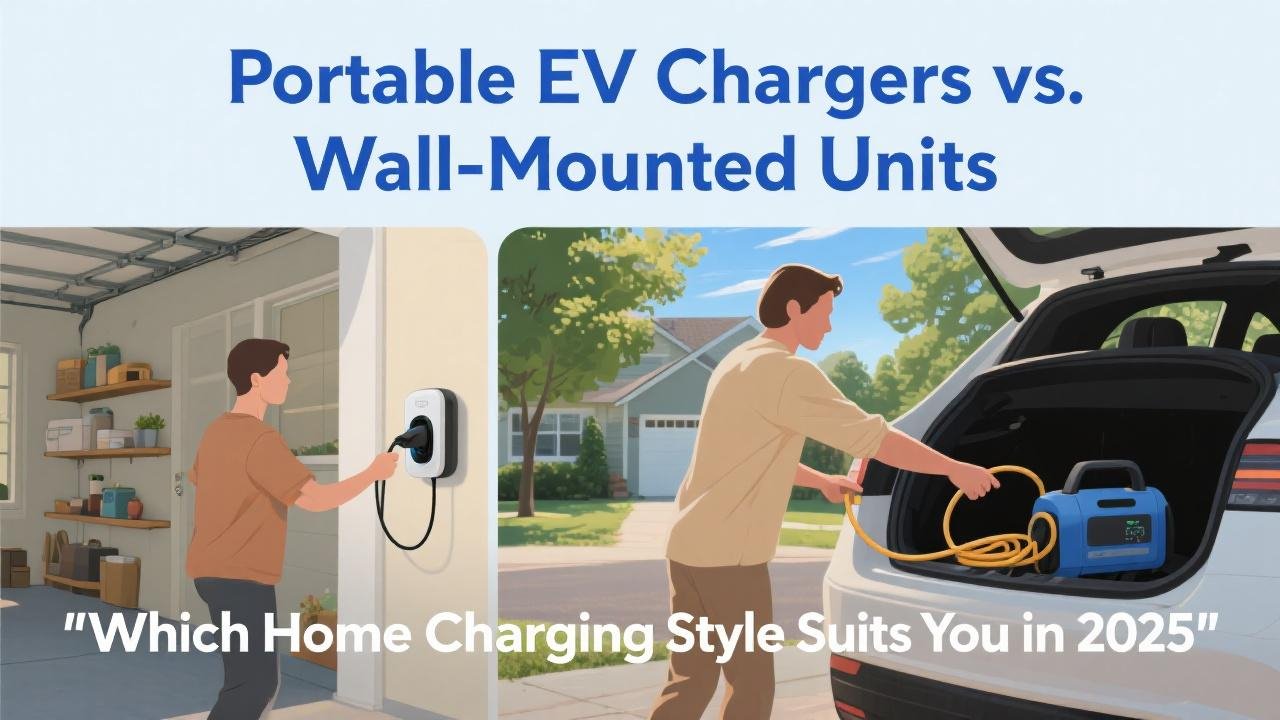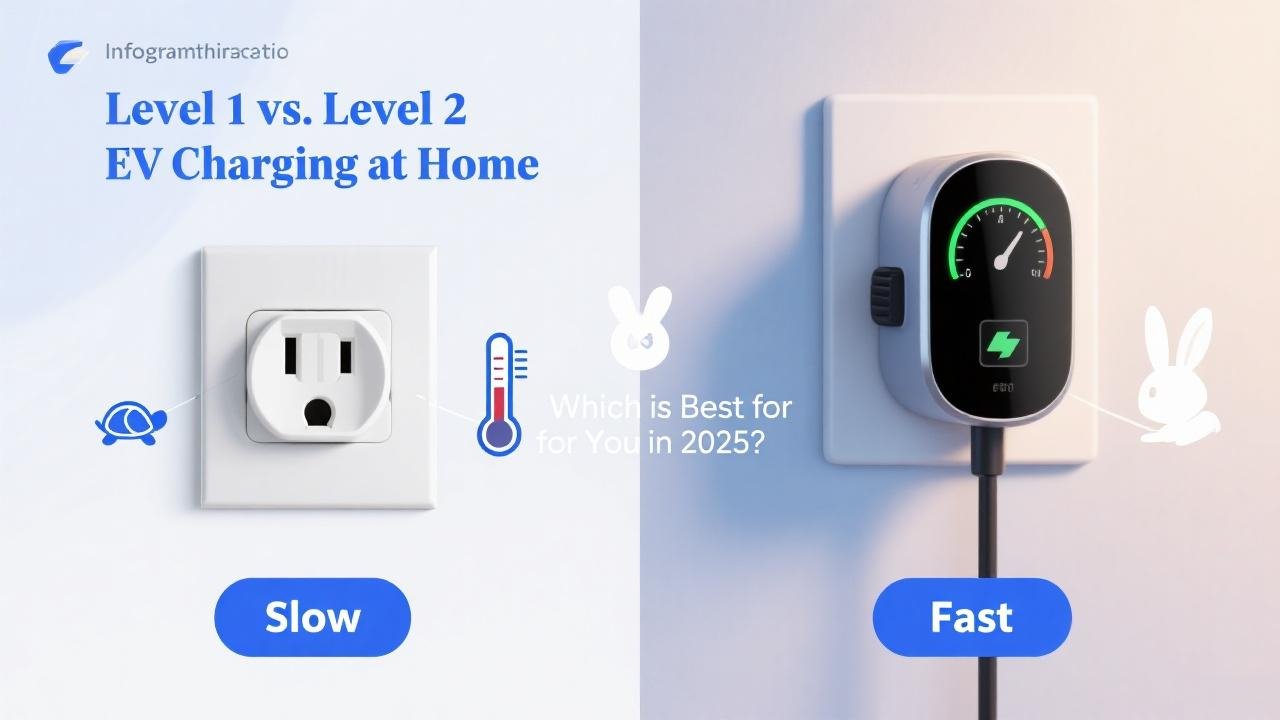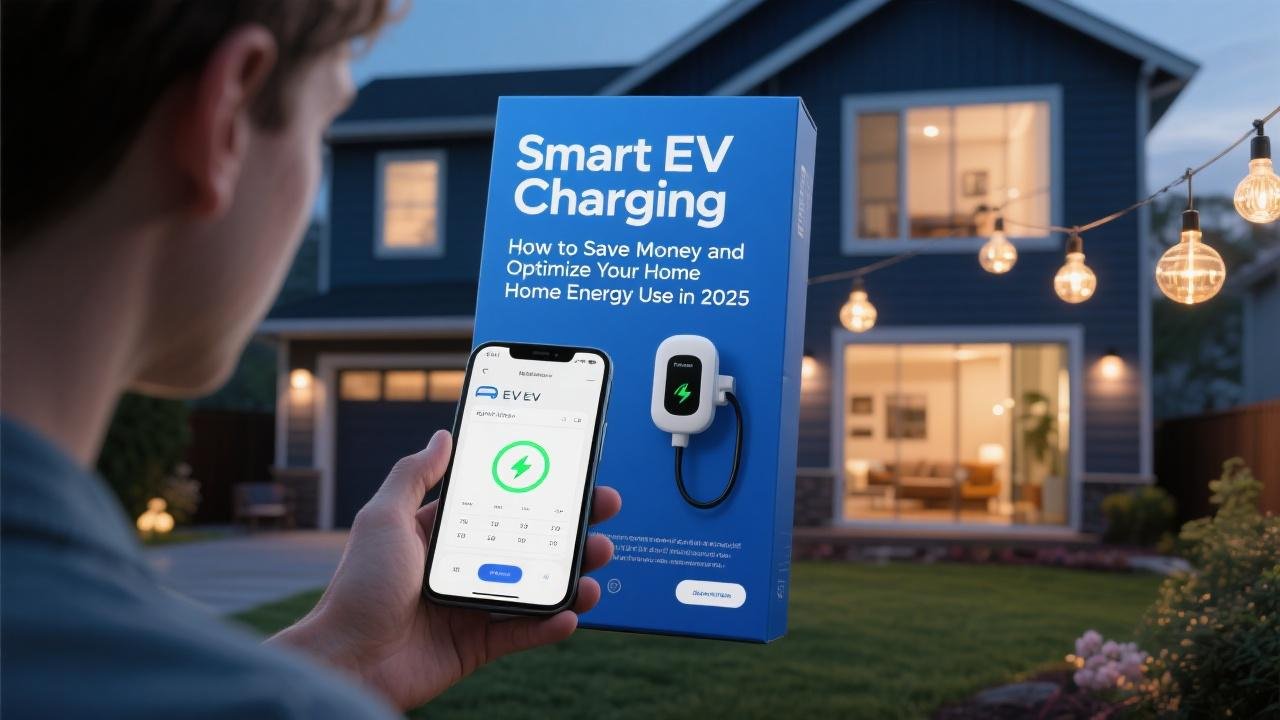Flexibility vs. Fixture in Your Home EV Charging Setup
Once you’ve decided to upgrade to Level 2 EV charging at home for faster and more convenient power-ups in 2025, another choice emerges: should you opt for a portable Level 2 charger or a permanently wall-mounted unit? Both provide the benefits of 240-volt charging, but they differ in terms of flexibility, installation, features, and sometimes cost. Understanding these distinctions will help you select the charging style that best aligns with your lifestyle, parking situation, and future plans.
Wall-Mounted EV Chargers: The Dedicated Home Hub
Wall-mounted Level 2 chargers are designed to be a permanent fixture in your home, typically installed in a garage, carport, or on an exterior wall near your parking spot.
- How They Work: These units are directly hardwired into a dedicated 240-volt circuit by an electrician, or they may plug into a heavy-duty 240V NEMA outlet (like a NEMA 14-50) that an electrician installs.
- Examples: Many popular chargers like the ChargePoint Home Flex, Tesla Universal Wall Connector, and Wallbox Pulsar Plus are primarily designed as wall-mounted units.
- Pros:
- Robust and Secure Installation: Generally offers a very stable and durable setup.
- Often Higher Amperage Possible: Hardwired wall-mounted units can sometimes support higher amperages (e.g., 48A or 50A) if your home’s electrical panel has the capacity, leading to faster charging.
- Integrated Cable Management: Many models come with built-in hooks, holsters, or notches to neatly store the charging cable when not in use, keeping your garage tidy.
- Smart Features Common: A wide range of wall-mounted chargers are “smart” chargers, offering Wi-Fi connectivity, app control, scheduled charging, usage tracking, and load management.
- Aesthetic Appeal: Often designed to be sleek and blend in with garage or home exteriors.
- Cons:
- Not Portable: Once installed, they are not easily moved. If you relocate, you’ll likely leave the charger behind or pay an electrician to uninstall and reinstall it.
- Installation Can Be More Involved: Hardwiring can sometimes be more labor-intensive than simply installing a NEMA outlet.
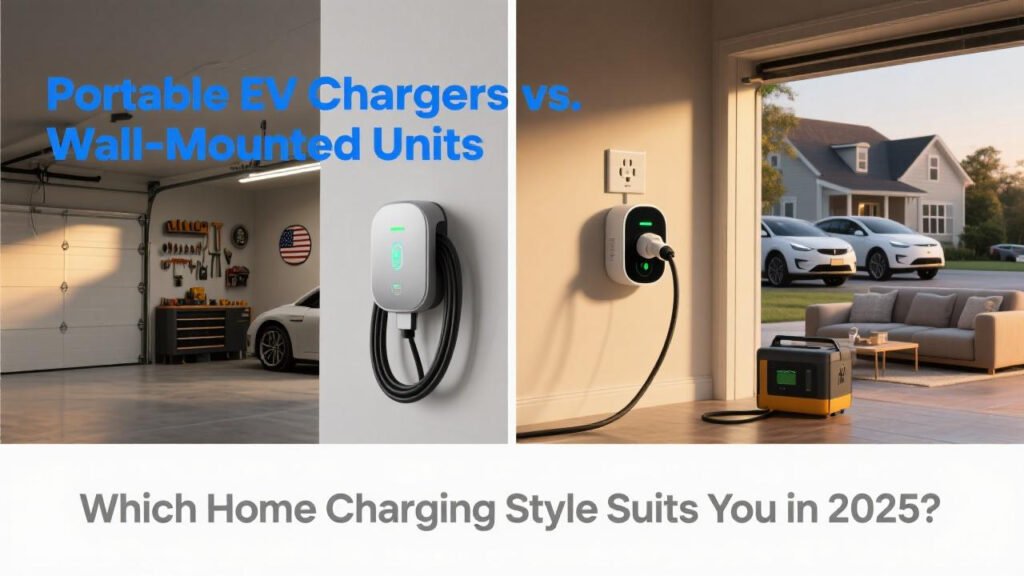
Portable Level 2 EV Chargers: Power On the Go (and At Home)
Portable Level 2 chargers offer more flexibility. These units typically have a control box with the charging circuitry and a plug that connects to a 240V NEMA outlet (commonly NEMA 14-50, the same type used for electric ranges or RVs).
- How They Work: An electrician installs the appropriate 240V NEMA outlet in your desired charging location. You then plug the portable charger into this outlet and connect the J1772 or NACS nozzle to your EV.
- Examples: Many brands offer portable Level 2 chargers, often emphasizing their adaptability. Some units, like the Evgoer J1772 32A EV Charger, come with adapters (e.g., a NEMA 5-15P adapter for Level 1 charging) to allow charging from different outlet types, though Level 2 speeds require a 240V outlet.
- Pros:
- Flexibility and Portability: The biggest advantage. You can easily unplug the charger and take it with you if you move, or potentially use it at a second home or RV park that has a compatible 240V outlet.
- Simpler Installation (Potentially): Installing a NEMA outlet might be slightly less labor-intensive for an electrician than hardwiring a unit in some cases, though this is not always true.
- Can Serve as a Backup/Travel Charger: Even if you have a primary wall-mounted unit, a portable Level 2 charger can be a good backup or a charger to take on road trips for use at destinations with 240V outlets.
- Often More Affordable (Charger Unit): Some basic portable Level 2 chargers might have a lower upfront cost for the unit itself compared to feature-rich wall-mounted smart chargers.
- Cons:
- May Offer Fewer Smart Features: While some portable units are becoming smarter, many basic models lack the advanced app control, scheduling, or load management features common in wall-mounted smart chargers.
- Cable Management Can Be Less Integrated: You might need to manually coil the cable or use a separate wall hook, as integrated solutions are less common.
- Durability Concerns (if frequently moved): Constant plugging/unplugging and transport could potentially lead to more wear and tear on the plug and cable over time compared to a fixed unit.
- Potential for Lower Amperage: Many portable chargers are designed for common NEMA 14-50 outlets, which typically support up to 40A charging (on a 50A circuit). Achieving higher amperages (like 48A or 50A) usually requires a hardwired setup.
Key Considerations for Your Choice in 2025:
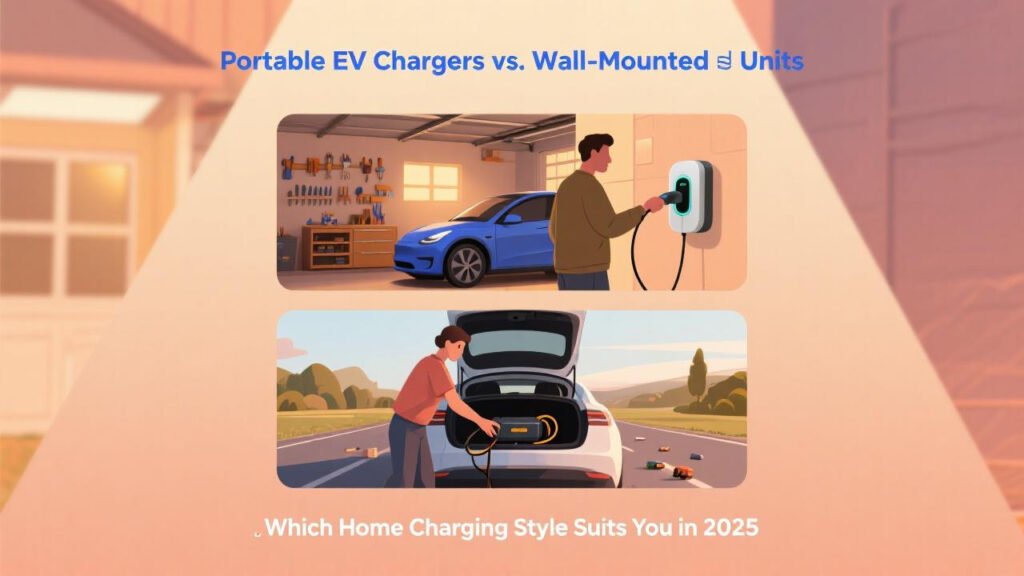
- Homeownership vs. Renting:
- Homeowners: Both options are viable. If you plan to stay in your home long-term, a wall-mounted unit might offer a cleaner, more integrated solution. If you anticipate moving, a plug-in portable unit offers easy relocation.
- Renters: A portable Level 2 charger (plugging into an existing or landlord-approved 240V outlet) is often the only feasible option, as hardwiring is usually not permitted.
- Need for Portability: Do you have a second home, frequently visit locations with 240V outlets, or want a charger you can easily take if you move? If yes, a portable charger is advantageous.
- Desired Charging Speed and Features:
- If you want the absolute fastest Level 2 charging your home panel can support and desire advanced smart features like load management or deep utility rate integration, a hardwired smart wall-mounted unit is often the best choice.
- If moderate Level 2 speeds are sufficient and you don’t need extensive smart features, a basic portable or plug-in wall unit can be more cost-effective.
- Budget:
- Charger Cost: Basic portable chargers can be cheaper than high-end smart wall-mounted units.
- Installation Cost: This can vary. Sometimes installing a NEMA outlet for a portable charger is slightly cheaper than hardwiring, but complex wire runs can make either option expensive. Always get quotes from electricians.
- Garage/Parking Setup: Consider the aesthetics and convenience of cable management in your charging area. Wall-mounted units often provide neater solutions.
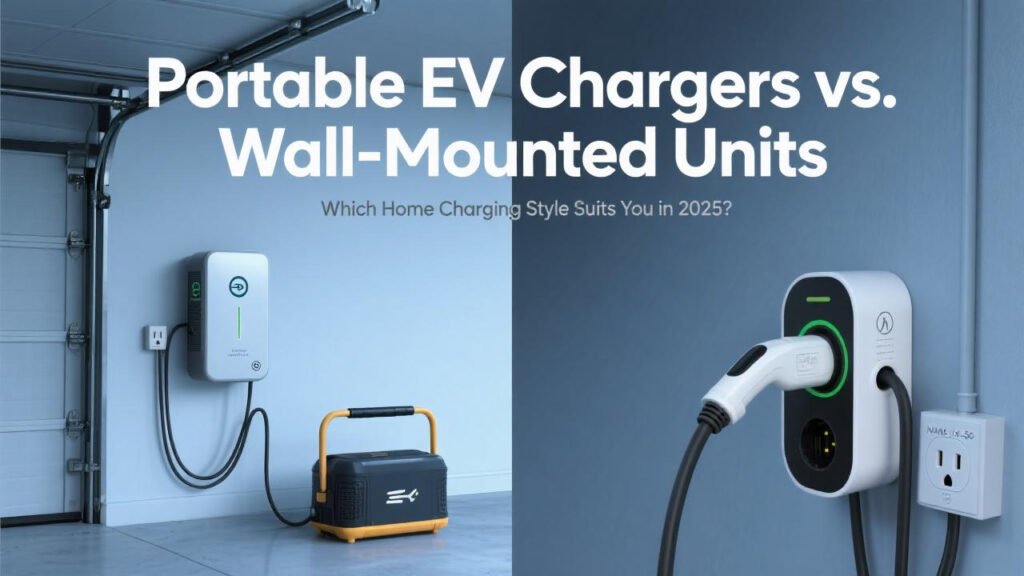
Can a Wall-Mounted Charger Be Plug-In?
Yes, many wall-mounted chargers are designed to be plugged into a NEMA 14-50 or 6-50 outlet, offering a “best of both worlds” scenario: a fixed, tidy installation with the option to unplug and take the unit if you move. The Tesla Universal Wall Connector and ChargePoint Home Flex can often be installed this way. This is a very popular approach.
Matching Your Charger to Your Lifestyle
The choice between a portable and a wall-mounted Level 2 EV charger in 2025 depends on your individual needs and circumstances. If you value maximum flexibility, are renting, or anticipate moving soon, a portable Level 2 charger offers significant advantages. If you own your home, plan to stay long-term, desire the fastest possible home charging speeds, and appreciate integrated smart features and neat cable management, a wall-mounted unit (either hardwired or plugged into a NEMA outlet) is often the preferred solution.
Regardless of your choice, ensure professional installation by a licensed electrician to guarantee safety and code compliance. Discuss your needs with them and consider getting quotes for both types of installations if you’re undecided. For a broader view of how EV charging fits into your home’s energy ecosystem, including potential solar integration, resources like EnergySage can offer valuable guidance.

